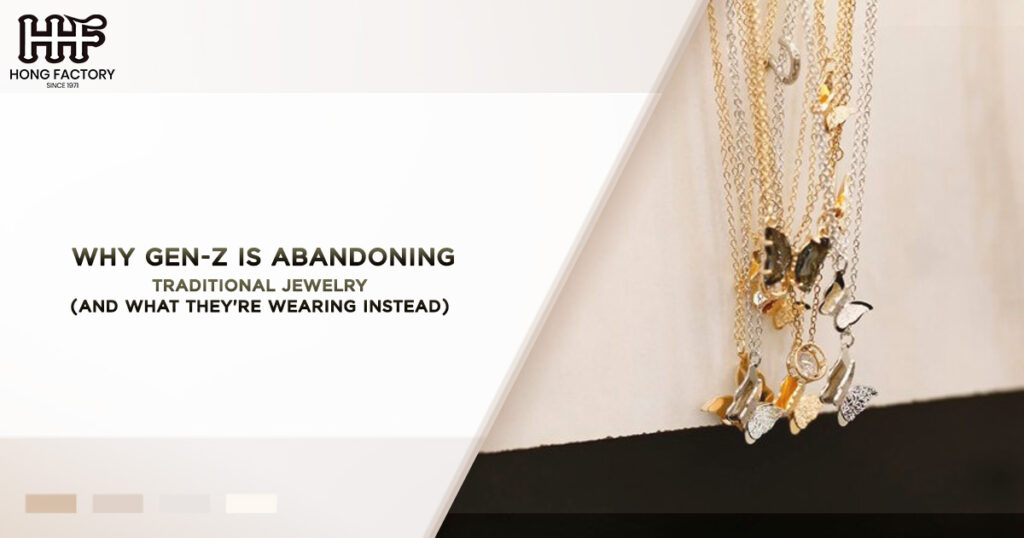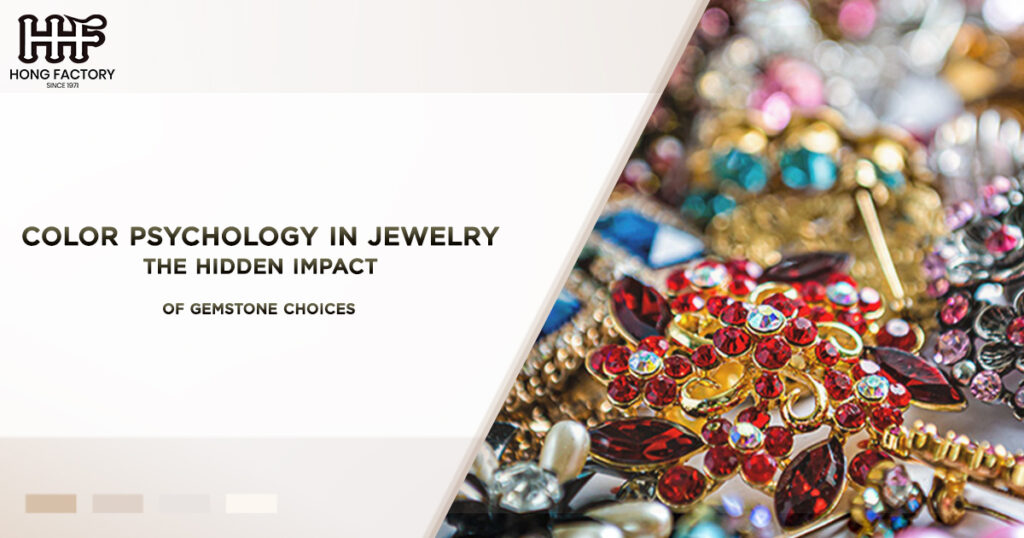
Jewelry has always been a timeless expression of identity, culture, and personal style. However, as the world evolves, so do generational tastes, preferences, and values. For decades, traditional jewelry—think gold bangles, diamond solitaires, and gemstone-encrusted necklaces—has been a staple of personal adornment, passed down through generations as heirlooms or purchased to mark significant life milestones. Yet, something interesting is happening : Gen-Z, the cohort born roughly between 1997 and 2012, is rewriting the rules on what jewelry means to them. They are moving away from conventional designs and materials, embracing pieces that are less about status and more about individuality, sustainability, and versatility.
This shift in aesthetic and value-driven consumption signals a broader generational transformation. In this article, we’ll dive into the changing jewelry preferences of Gen-Z, explore modern jewelry trends, and uncover what this means for the future of the industry.
The Changing Jewelry Landscape – Why Gen-Z Is Moving Away From Tradition
A Generational Shift in Values
Unlike their predecessors, Gen-Z is less concerned with the permanence and prestige that traditional jewelry symbolizes and more focused on what their adornments say about their personal values and identity. Traditional jewelry—often associated with wealth, family legacy, and conventional beauty ideals—doesn’t always align with the priorities of this younger generation.
Gen-Z’s choices are shaped by several key factors
- Individuality and Self-Expression
Gen-Z values self-expression above all else. Rather than adhering to societal expectations or mimicking the styles of previous generations, they seek out unique, customizable, and meaningful pieces that tell their story. Traditional jewelry often lacks the personal flair they crave, instead offering mass-produced designs or ones steeped in rigid cultural norms.
- Sustainability and Ethical Concerns
This is a generation hyper-conscious of the environmental and ethical impact of their purchases. Traditional jewelry, particularly diamonds and gold, has long been criticized for unethical mining practices, environmental harm, and exploitative labor conditions. Gen-Z is actively seeking alternatives that align with their commitment to sustainability, such as lab-grown diamonds, recycled metals, or even handmade artisan jewelry.
- Experiences Over Materialism
Many Gen-Zers prioritize experiences over possessions. Lavish, expensive jewelry pieces that require significant investment may seem unnecessary or even wasteful to them. Instead, they gravitate toward affordable, versatile pieces that can be worn daily, allowing them to allocate more of their resources to travel, hobbies, or technology.
- Rejection of Gender Norms
Traditional jewelry often conforms to rigid gender norms, with separate designs for men and women. However, Gen-Z celebrates fluidity in gender and identity, seeking out pieces that are androgynous, unisex, or versatile enough to transcend these outdated binaries.
Modern Jewelry Trends – What Gen-Z Is Wearing Instead
As traditional jewelry takes a backseat, a new wave of modern jewelry trends has emerged, capturing the hearts and imaginations of Gen-Z. Their preferences reflect a desire for creativity, inclusivity, and adaptability. Let’s explore the key trends defining this generational shift.
1. Minimalism and Everyday Wear
Gen-Z has embraced minimalist jewelry that complements their increasingly casual lifestyles. Delicate chains, small hoop earrings, stackable rings, and tiny studs are popular because they are subtle, lightweight, and versatile. These pieces can easily transition from day to night, fitting seamlessly into Gen-Z’s fast-paced routines and preference for simplicity.
Minimalist styles also reflect a break from the ostentatious designs of traditional jewelry, signaling a preference for understated elegance rather than overt displays of wealth.
2. Body Jewelry and Piercings
Body jewelry, including nose rings, belly button piercings, and ear cuffs, has seen a surge in popularity among younger generations. These pieces are bold, edgy, and often customizable, offering Gen-Z the opportunity to express their individuality. Unlike traditional jewelry, which is often limited to the neck, wrists, and fingers, body jewelry allows for more creative self-expression.
The rise of body jewelry also reflects Gen-Z’s embrace of alternative aesthetics, such as punk, grunge, and Y2K fashion trends.
3. Gender-Neutral Designs
Gen-Z’s push for inclusivity has driven a rise in gender-neutral jewelry. Unisex signet rings, chunky chain necklaces, and bold cuff bracelets are among the designs gaining traction. These pieces are designed to appeal to people of all genders, breaking down the barriers between traditionally “masculine” and “feminine” styles.
The popularity of gender-neutral jewelry also reflects a broader cultural shift toward fluidity and acceptance, values deeply ingrained in Gen-Z.
4. Sustainable and Ethical Jewelry
Sustainability is a top priority for Gen-Z, and this extends to their jewelry choices. The demand for lab-grown diamonds, recycled metals, and ethically sourced gemstones has skyrocketed. Brands that prioritize transparency, fair labor practices, and eco-friendly production methods are winning over this generation.
Additionally, many Gen-Z consumers are turning to vintage and secondhand jewelry as a sustainable alternative. By repurposing pre-loved pieces, they can reduce waste while owning something truly unique.
5. Playful and Nostalgic Designs
From colorful beaded necklaces to charm bracelets, Gen-Z is embracing jewelry that feels fun, nostalgic, and youthful. These designs often draw inspiration from the late 1990s and early 2000s, a nod to the Y2K aesthetic that has made a major comeback in recent years. Bold colors, quirky shapes, and whimsical motifs (like smiley faces or hearts) are all the rage, offering a refreshing departure from the seriousness of traditional jewelry.
6. Technology-Integrated Jewelry
As digital natives, Gen-Z is naturally drawn to tech-integrated accessories. Smart rings, bracelets with fitness trackers, and even high-tech jewelry that syncs with their smartphones are growing in appeal. These pieces marry style with functionality, reflecting Gen-Z’s tech-savvy nature and practical mindset.
Youth Jewelry Preferences – What Drives Their Decisions?
To truly understand why Gen-Z is gravitating toward modern jewelry trends, it’s important to examine the underlying motivations behind their preferences. Here are some of the key drivers :
– Affordability : Unlike traditional jewelry, which often comes with a hefty price tag, modern options are more budget-friendly. Gen-Z appreciates affordable pieces that don’t compromise on quality or style.
– Customization : Personalized jewelry—whether it’s engraved initials, birthstones, or custom-made designs—holds immense appeal for a generation that values individuality.
– Versatility : Gen-Z loves pieces that can be layered, mixed, and matched to suit different moods and occasions.
– Social Media Influence : Platforms like Instagram, TikTok, and Pinterest heavily influence Gen-Z’s jewelry choices. Viral trends, influencer endorsements, and user-generated content drive demand for certain styles.
– Cultural Diversity : As one of the most ethnically diverse generations, Gen-Z celebrates cultural influences in jewelry. They’re open to adopting designs from different traditions, provided they are approached respectfully.
The Future of Jewelry – Adapting to Gen-Z’s Influence
The rise of Gen-Z as a dominant consumer demographic is reshaping the jewelry industry in profound ways. Brands that cling to traditional designs and values risk losing relevance in this rapidly evolving market. To thrive, jewelers must adapt by embracing modern jewelry trends, prioritizing sustainability, and offering products that resonate with the unique preferences of Gen-Z.
Some strategies for success include
- Investing in Ethical Practices : Brands must prioritize transparency in their supply chains and commit to sustainable production methods to earn Gen-Z’s trust.
- Offering Customization Options : Providing opportunities for personalization will help brands connect with this generation on a deeper level.
- Creating Affordable Collections : Accessible price points are key to capturing the attention of younger buyers.
- Engaging on Social Media : Social platforms are the primary way Gen-Z discovers and interacts with brands, making it essential for jewelers to have a strong online presence.
- Celebrating Diversity : Inclusive marketing and diverse product offerings will resonate with a generation that values representation and cultural exchange.
Conclusion
Gen-Z’s departure from traditional jewelry marks a significant cultural shift, one rooted in values like individuality, sustainability, and inclusivity. Modern jewelry trends—minimalism, body piercings, gender-neutral designs, and playful, tech-integrated pieces—reflect their desire for unique, meaningful, and versatile adornments that align with their lifestyles and beliefs.
As this influential generation comes of age, their impact on the jewelry industry is undeniable. By understanding and embracing their preferences, brands can not only stay relevant but also thrive in a market that increasingly prioritizes authenticity and innovation. The jewelry world is changing, and with Gen-Z at the helm, it’s becoming more exciting, inclusive, and dynamic than ever.


